-
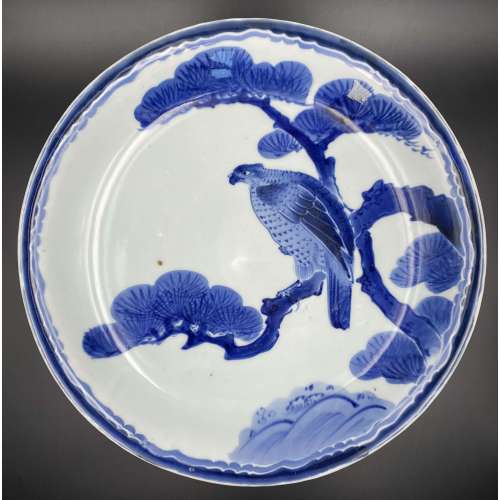 Underglaze cobalt blue and white porcelain plate decorated with a falcon on a pine tree and rough waves beneath; rim with a stylized wave design; seven spur marks on the reverse. Diameter: 31 cm; Height: 5 cm; Diameter of the foot: 18 cm.
Underglaze cobalt blue and white porcelain plate decorated with a falcon on a pine tree and rough waves beneath; rim with a stylized wave design; seven spur marks on the reverse. Diameter: 31 cm; Height: 5 cm; Diameter of the foot: 18 cm. -
 Artist: Utagawa Kunisada [歌川 国貞] a.k.a. Utagawa Toyokuni III [三代歌川豊国] (Japanese, 1786 – 1865). Signed: Gototei Kunisada ga [五渡亭国貞画]. Publisher: Ibaya Kyūbei [伊場屋 久兵衛] (Japanese, 1804 – 1851); seal Marks 08-055|126a. Date-aratame seal: Bunsei 13 / Tenpō 1 (1830). Actor: Nakamura Utaemon IV [中村歌右衛門] (Japanese, 1796 – 1852); other names: Nakamura Shikan II [中村芝翫], Nakamura Tsurusuke I, Nakamura Tōtarō. Play: Yoshitsune’s Letter at Koshigoe [義経腰越状] (Yoshitsune Koshigoe-jo). Uncut fan print (uchiwa-e, 団 扇 絵) depicting kabuki actor Nakamura Shikan [中村芝翫] as Gotobei [五斗兵衛], dressed in a green kimono with hanging wisteria crest (sagari fuji mon) on the shoulder, posing behind a large saké cask. Nakamura Utaemon IV held the name of Nakamura Shikan II from the 11th lunar month of 1825 to the 1st lunar month of 1836. He was born as Hirano Kichitarō in Edo in 1796. Another fan print with the same subject in this collection [SVJP-0349.2021]; there are also more details about the play and its heroes.
Artist: Utagawa Kunisada [歌川 国貞] a.k.a. Utagawa Toyokuni III [三代歌川豊国] (Japanese, 1786 – 1865). Signed: Gototei Kunisada ga [五渡亭国貞画]. Publisher: Ibaya Kyūbei [伊場屋 久兵衛] (Japanese, 1804 – 1851); seal Marks 08-055|126a. Date-aratame seal: Bunsei 13 / Tenpō 1 (1830). Actor: Nakamura Utaemon IV [中村歌右衛門] (Japanese, 1796 – 1852); other names: Nakamura Shikan II [中村芝翫], Nakamura Tsurusuke I, Nakamura Tōtarō. Play: Yoshitsune’s Letter at Koshigoe [義経腰越状] (Yoshitsune Koshigoe-jo). Uncut fan print (uchiwa-e, 団 扇 絵) depicting kabuki actor Nakamura Shikan [中村芝翫] as Gotobei [五斗兵衛], dressed in a green kimono with hanging wisteria crest (sagari fuji mon) on the shoulder, posing behind a large saké cask. Nakamura Utaemon IV held the name of Nakamura Shikan II from the 11th lunar month of 1825 to the 1st lunar month of 1836. He was born as Hirano Kichitarō in Edo in 1796. Another fan print with the same subject in this collection [SVJP-0349.2021]; there are also more details about the play and its heroes. Horst Graebner also noted that the performance took place at Nakamura Theatre in Edo on Bunsei 13/03 (03/1830) (see Waseda University Cultural Resources Database # 100-4224):
Horst Graebner also noted that the performance took place at Nakamura Theatre in Edo on Bunsei 13/03 (03/1830) (see Waseda University Cultural Resources Database # 100-4224):

Toyokuni II
-
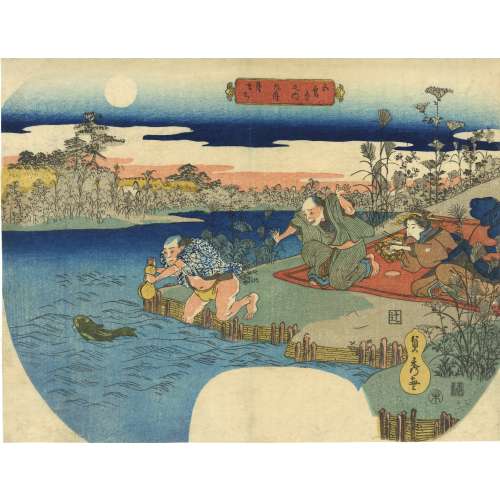 Artist: Utagawa Sadahide [歌川貞秀] (Japanese, 1807 – 1879). Publisher: Iseya Ichiemon [伊勢屋市右衛門] (Japanese, fl. c. 1820s – c. 1860s). Size: Uncut fan print (uchiwa-e), 220 x 285 mm. Date-kiwame seal: 1835 (Tenpō 6). Signed: Sadahide ga in a double-gourd cartouche. Man trying to catch a catfish with a gourd during a picnic on an autumn evening. Five Festivals [五節句の內] (Gosekku no uchi), Ninth Month [九月] (Kugatu), Full moon celebration on the 15th night of the month (Tsuki machi) [月まち] or [月待]. The autumnal spirit is also supported by the presence of Patrinia scabiosifolia (ominaeshi) [女郎花] and Miscanthus sinensis, or Japanese pampas grass (susuki) [薄]. These two are part of the Seven Grasses of Autumn (aki no nanakusa) [秋の七草]. Description by Richard Kruml: "Viewing the full moon in the eighth and ninth months was a popular activity passed down from the aristocracy in Heian times; especially where the moon's reflection could be seen in the water. One such party is seen here where a member vainly attempts to catch a catfish with a gourd: A hopeless task with such an unsuitable utensil. This is based on a Zen riddle posed by the shōgun Ashikaga Yoshimochi [足利 義持] (Japanese, 1386 – 1428) on how to catch a catfish with a gourd, which inspired the 15th-century artist Josetsu [如拙] (Japanese, fl. 1405 – 1496) to paint the subject with accompanying poems on the conundrum by Zen monks".
Artist: Utagawa Sadahide [歌川貞秀] (Japanese, 1807 – 1879). Publisher: Iseya Ichiemon [伊勢屋市右衛門] (Japanese, fl. c. 1820s – c. 1860s). Size: Uncut fan print (uchiwa-e), 220 x 285 mm. Date-kiwame seal: 1835 (Tenpō 6). Signed: Sadahide ga in a double-gourd cartouche. Man trying to catch a catfish with a gourd during a picnic on an autumn evening. Five Festivals [五節句の內] (Gosekku no uchi), Ninth Month [九月] (Kugatu), Full moon celebration on the 15th night of the month (Tsuki machi) [月まち] or [月待]. The autumnal spirit is also supported by the presence of Patrinia scabiosifolia (ominaeshi) [女郎花] and Miscanthus sinensis, or Japanese pampas grass (susuki) [薄]. These two are part of the Seven Grasses of Autumn (aki no nanakusa) [秋の七草]. Description by Richard Kruml: "Viewing the full moon in the eighth and ninth months was a popular activity passed down from the aristocracy in Heian times; especially where the moon's reflection could be seen in the water. One such party is seen here where a member vainly attempts to catch a catfish with a gourd: A hopeless task with such an unsuitable utensil. This is based on a Zen riddle posed by the shōgun Ashikaga Yoshimochi [足利 義持] (Japanese, 1386 – 1428) on how to catch a catfish with a gourd, which inspired the 15th-century artist Josetsu [如拙] (Japanese, fl. 1405 – 1496) to paint the subject with accompanying poems on the conundrum by Zen monks". -
 Artist: Utagawa Kunisada [歌川 国貞], a.k.a. Utagawa Toyokuni III [三代 歌川 豊国] (Japanese, 1786 – 1865). Signed: Toyokuni ga [豊国 画] in a red toshidama cartouche Block carver: Yokokawa Takejirō [横川竹二郎] (Japanese, fl. 1845 – 1863); seal: Hori Take [彫竹]. Publisher: Iseya Magobei [伊勢屋孫兵衛] (Japanese, fl. c. 1794 – 1868); seal: Hanmoto, Masu [板元, 益] (Marks 19-039 | 150d). Date-aratame seal: Ansei 2 (1855). Title: Time in Fukagawa, Iyo Province (Fukagawa Iyo setsu). Ref.: [LIB-3008.2022] Andreas Marks. Japanese woodblock prints: Artists, publishers and masterworks, 1680 – 1900. — Tuttle Publishing, 2010; p. 221. –> 1855 Kunisada. "Iyo Province-time at Fukagawa" (Fukagawa Iyo setsu). Fan print. Japan Ukiyo-e Museum, Matsumoto.
Artist: Utagawa Kunisada [歌川 国貞], a.k.a. Utagawa Toyokuni III [三代 歌川 豊国] (Japanese, 1786 – 1865). Signed: Toyokuni ga [豊国 画] in a red toshidama cartouche Block carver: Yokokawa Takejirō [横川竹二郎] (Japanese, fl. 1845 – 1863); seal: Hori Take [彫竹]. Publisher: Iseya Magobei [伊勢屋孫兵衛] (Japanese, fl. c. 1794 – 1868); seal: Hanmoto, Masu [板元, 益] (Marks 19-039 | 150d). Date-aratame seal: Ansei 2 (1855). Title: Time in Fukagawa, Iyo Province (Fukagawa Iyo setsu). Ref.: [LIB-3008.2022] Andreas Marks. Japanese woodblock prints: Artists, publishers and masterworks, 1680 – 1900. — Tuttle Publishing, 2010; p. 221. –> 1855 Kunisada. "Iyo Province-time at Fukagawa" (Fukagawa Iyo setsu). Fan print. Japan Ukiyo-e Museum, Matsumoto. -
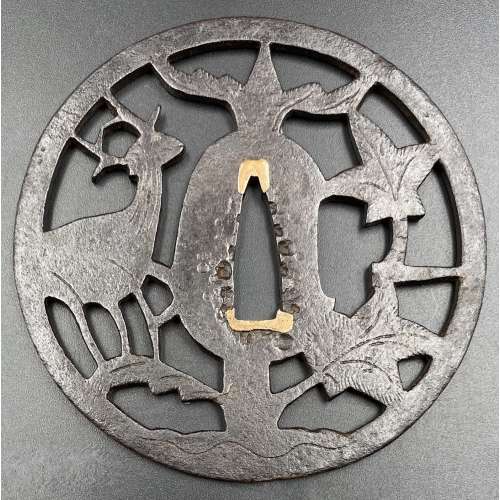
Iron tsuba of round form decorated with a deer and maple leaves in positive silhouette openwork (ji-sukashi), with details finely carved in low relief (kebori). Nakagō-ana plugged with copper fittings (sekigane). Traces of lacquer on the surface.
NBTHK: Hozon, №424947.
Design: An autumnal tsuba with an allusion to Kasuga Shrine in Nara.
Attributed by NBTHK to Shoami. Age: Probably the Momoyama period (1574 – 1603) or early Edo period (1603 – 1650), but judging on the item's substantial size (diameter 86.6 mm) and considerable thinness (3.4 mm) may be attributed to earlier times (late Muromachi period, 1514 – 1573). -
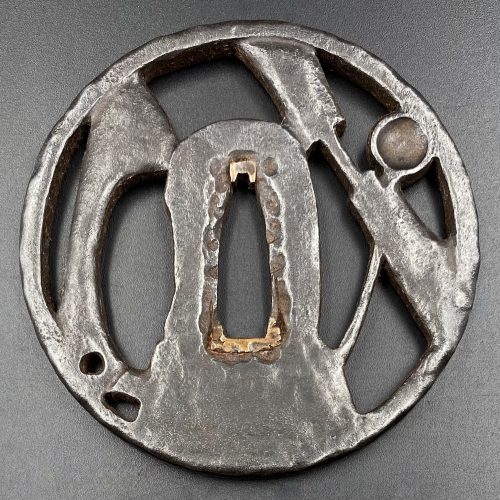 Iron tsuba of round form decorated with a ladle, pestle, mortar, and rice sickle in positive silhouette openwork (nikubori-ji-sukashi). Slightly rounded rim with iron bones (tekkotsu). Seppa-dai plugged with copper fittings (sekigane). Silver patina. The design resembles mochi-making utensils; mochi (rice cake) symbolizes longevity. Kanayama school, c. 1590 (Momoyama period). Note: unusually large size for a Kanayama tsuba: diameter 79.5 mm, thickness at seppa-dai: 5.5 mm, at rim: 6.0 mm. Concerning the design: While the ladle and pestle are clear, the mortar (under the seppa-dai), and the sickle (to the left) require certain imagination.
Iron tsuba of round form decorated with a ladle, pestle, mortar, and rice sickle in positive silhouette openwork (nikubori-ji-sukashi). Slightly rounded rim with iron bones (tekkotsu). Seppa-dai plugged with copper fittings (sekigane). Silver patina. The design resembles mochi-making utensils; mochi (rice cake) symbolizes longevity. Kanayama school, c. 1590 (Momoyama period). Note: unusually large size for a Kanayama tsuba: diameter 79.5 mm, thickness at seppa-dai: 5.5 mm, at rim: 6.0 mm. Concerning the design: While the ladle and pestle are clear, the mortar (under the seppa-dai), and the sickle (to the left) require certain imagination. -
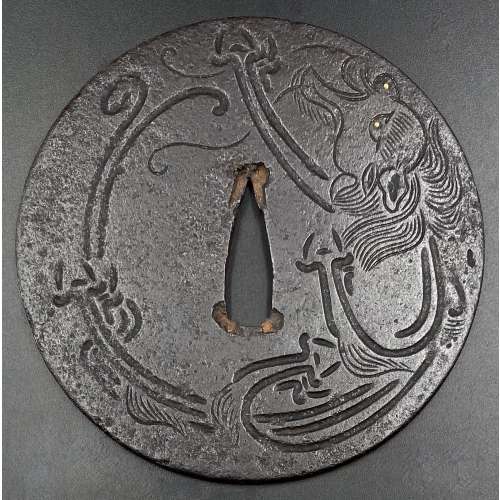 Iron tsuba of round form, on both sides decorated in low relief (kebori) with a dragon, eyes inlaid in brass. NBTHK: Hozon, № 4011013. Kamakura-bori type of tsuba. Med-Muromachi period, c. 1450. Diameter: 90 mm; Thickness (centre): 3.3 cm, Thickness (rim): 2.4 cm Reference: Japanese Swords and Sword Fittings from the Collection of Dr Walter Ames Compton (Part I). — NY: Christie's, 1992, p. 10, №2. Obviously, Compton's tsuba has an altered nakago-ana and placed on the photo upside down. Compton's tsuba has a raised mimi, while mine does not.
Iron tsuba of round form, on both sides decorated in low relief (kebori) with a dragon, eyes inlaid in brass. NBTHK: Hozon, № 4011013. Kamakura-bori type of tsuba. Med-Muromachi period, c. 1450. Diameter: 90 mm; Thickness (centre): 3.3 cm, Thickness (rim): 2.4 cm Reference: Japanese Swords and Sword Fittings from the Collection of Dr Walter Ames Compton (Part I). — NY: Christie's, 1992, p. 10, №2. Obviously, Compton's tsuba has an altered nakago-ana and placed on the photo upside down. Compton's tsuba has a raised mimi, while mine does not.
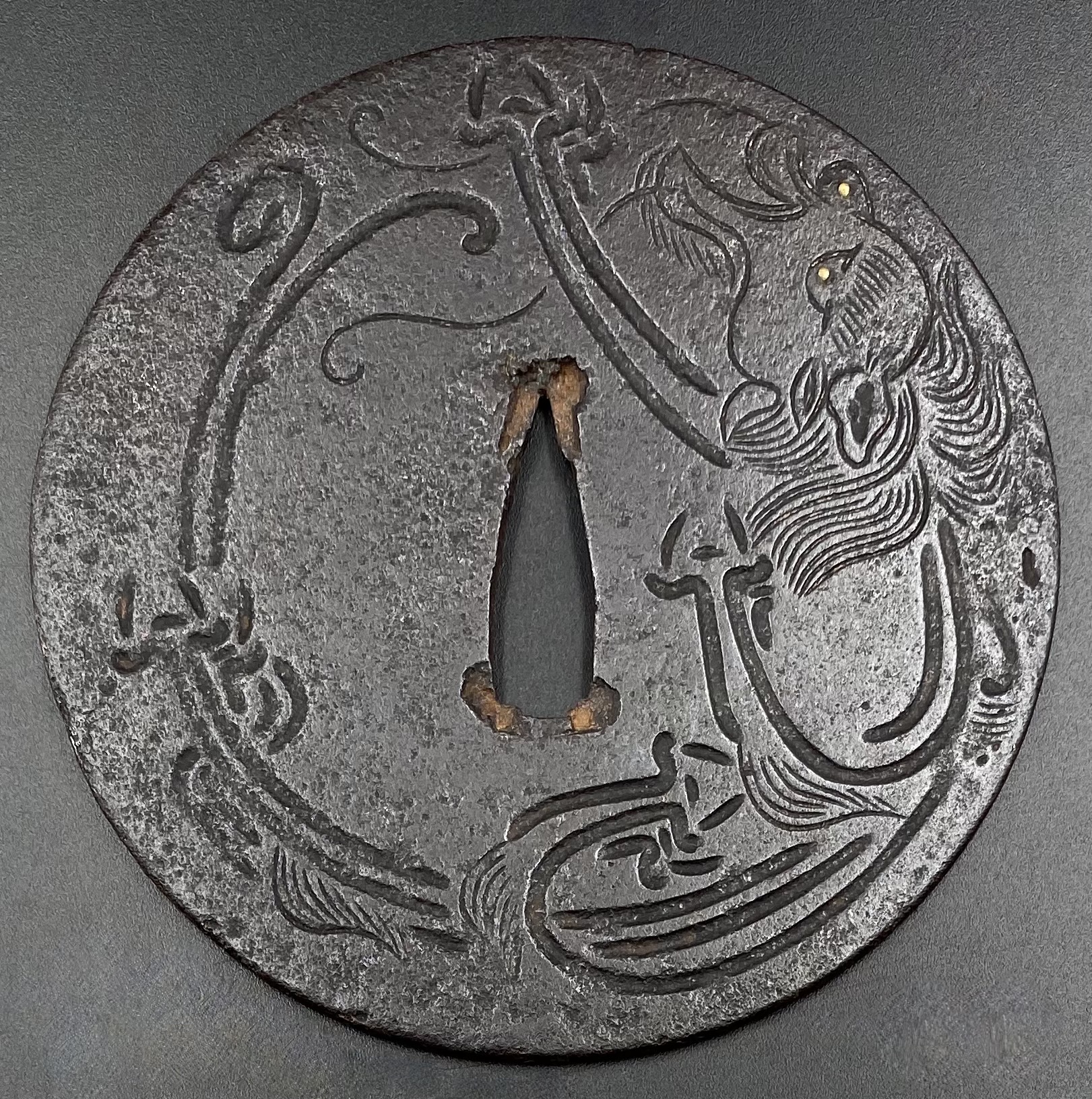 Two other examples of the same design may be found at: (1) Christie, Manson & Woods auction sales “Kotetsu”, 1980, page 12, №10 and (2) Professor A. Z. Freeman and the Phyllis Sharpe Memorial collections №36, pp. 18-19. Both have raised mimi, the latter classified as Katchushi tsuba.
More about Kamakura-bori tsuba here.
Two other examples of the same design may be found at: (1) Christie, Manson & Woods auction sales “Kotetsu”, 1980, page 12, №10 and (2) Professor A. Z. Freeman and the Phyllis Sharpe Memorial collections №36, pp. 18-19. Both have raised mimi, the latter classified as Katchushi tsuba.
More about Kamakura-bori tsuba here.
-
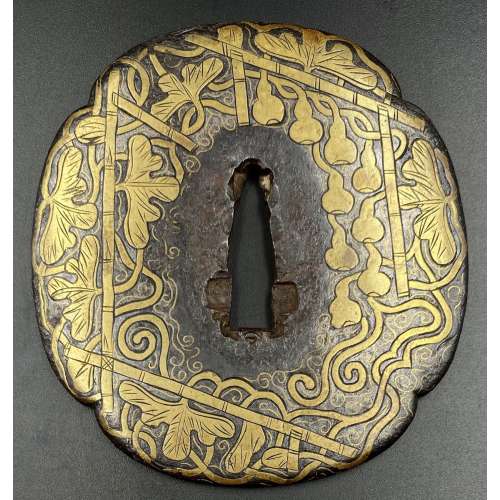
Iron tsuba of mokko form decorated with trellis, vines, foliage, and gourds inlaid in brass with details carved in low relief.
NBTHK: Tokubetsu Hozon №2003186.
Momoyama period (1574 – 1603). Dimensions: H: 85.5 cm, W: 79 mm, Thickness (centre): 4.8 mm. Tsuba of a similar design can be found in this collection [TSU-0373]. In that example, the plate was later pierced with geometrical mon-like openwork to resemble Koike Yoshirō's handguards. More about this type of tsuba here.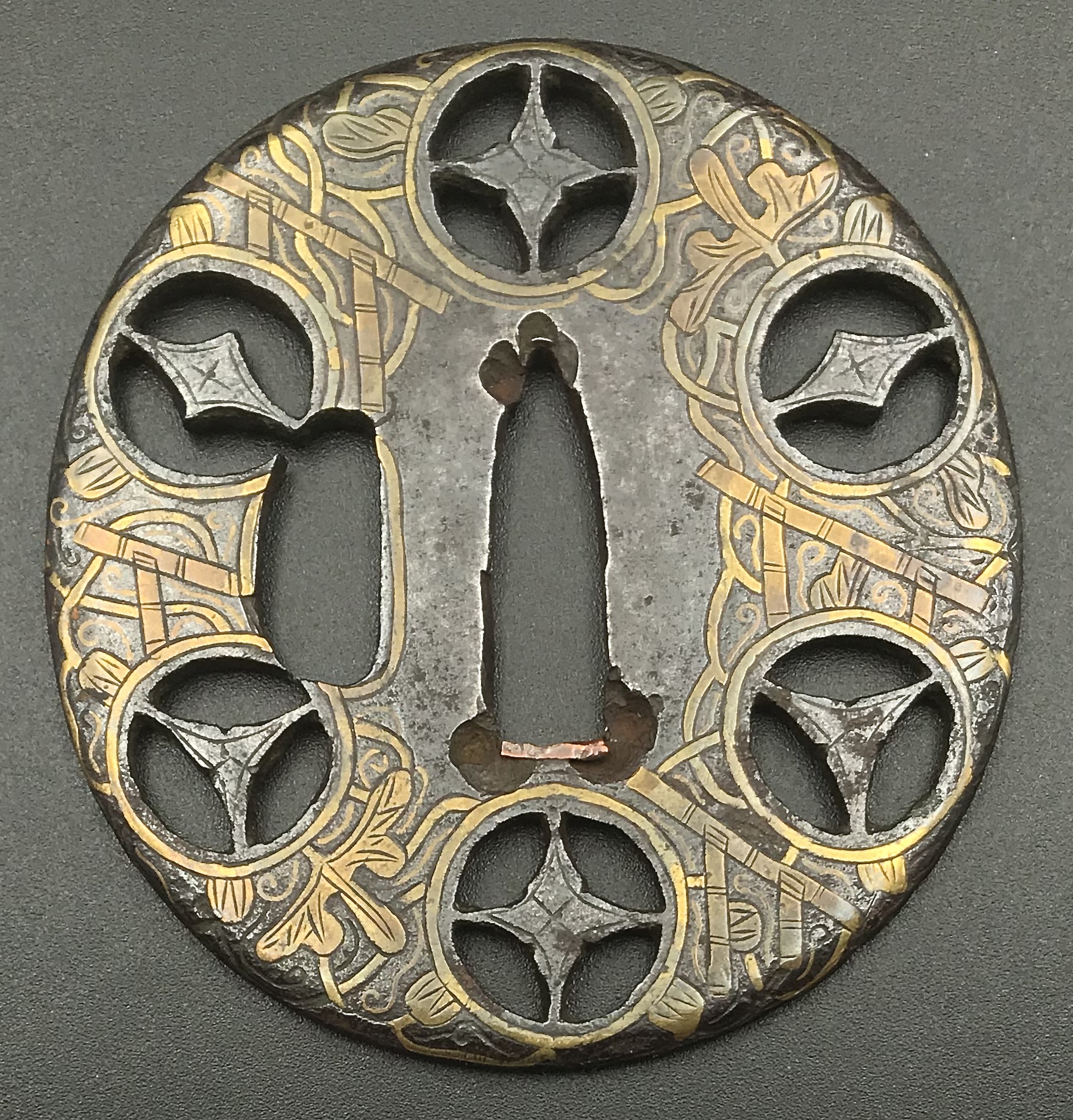
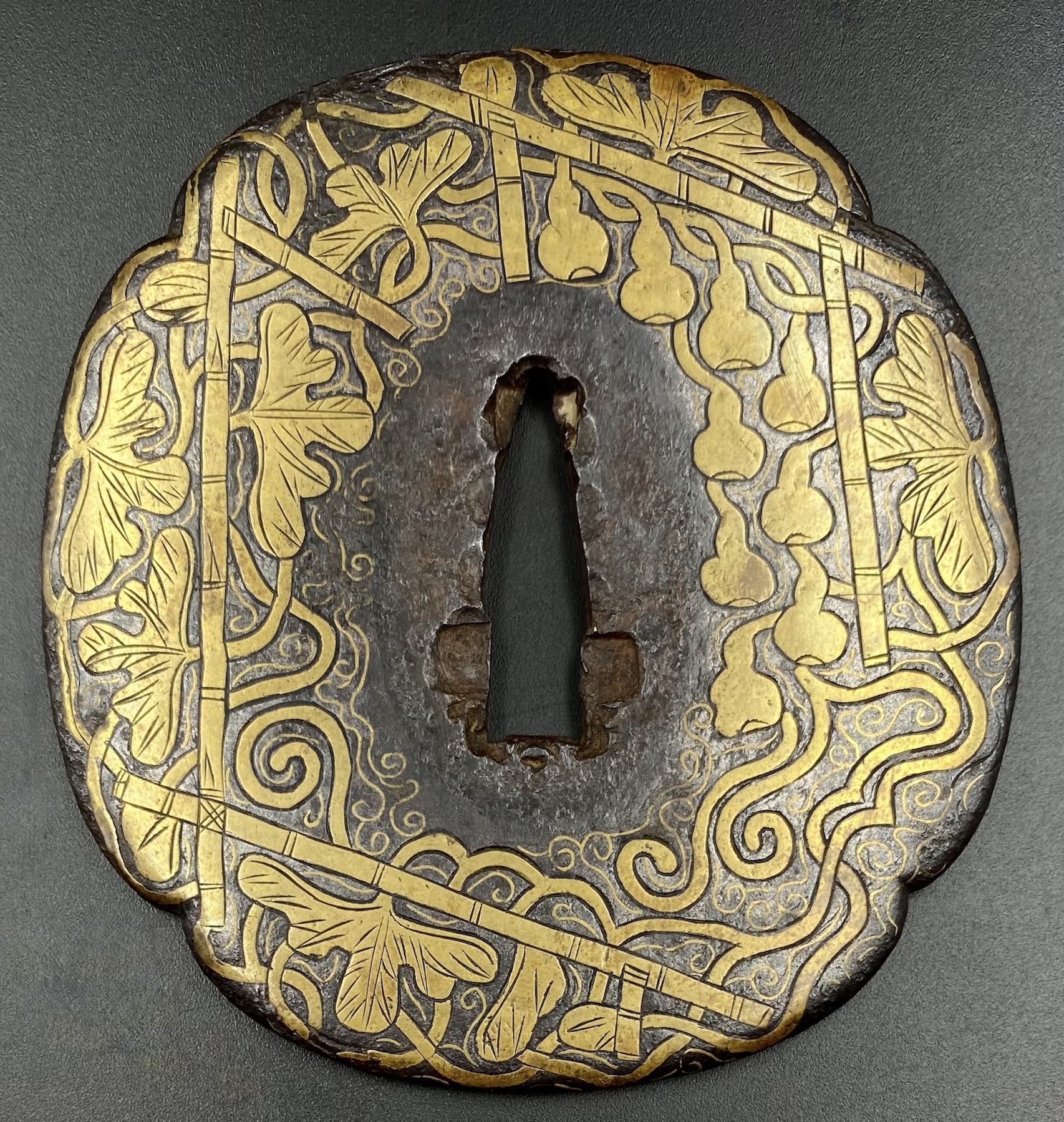
-
 Sawamura Gennosuke II [沢村源之助] (Suketakaya Takasuke III, Sawamura Chōjūrō V, Sawamura Sōjūrō V, Sawamura Tosshō I, Sawamura Genpei I, Japanese, 1802/7 – 1853) as Ushiwakamaru [牛若丸], a.k.a. Minamoto no Yoshitsune [源 義経]. Ichikawa Danjūrō VII [市川団十郎] (Ichikawa Ebizō V, Ichikawa Hakuen II, Ichikawa Shinnosuke I, Japanese, 1791 – 1859) as Benkei, a.k.a. Saitō Musashibō Benkei [西塔武蔵坊弁慶] (Japanese, 1155 – 1189) Performance: Grand finale dance play [大切所作事] (ōgiri shosagoto) at Soga Festival - A Composite Piece of Musashi「曽我祭武蔵摂物 ごさいれいむさしのひきもの)」 (Gosairei Musashi no hikimono), performed at Kawarazakiza (河原崎座) in 05/1831 (See kabuki plays from 1831). Soga Festival (Soga Matsuri) is an annual theatre event in Edo (Tokyo). Scene: The Fight on Gojo Bridge or Benkei on the Bridge [橋弁慶] (Hashi Benkei). The story relates how Benkei, first a monk, then a mountain ascetic, and then a rogue warrior, a man of Herculean strength, was subdued by the young Onzoshi Ushiwaka Maru (Yoshitsune) on Gojo Bridge. Benkei wandered around Kyoto with the intention of relieving 1000 samurai of their swords. One night, with one more sword to go, he saw Yoshitsune playing the flute and wearing a golden sword at the Gojotenjin Shrine. They agreed to fight on Gojo Bridge in southern Kyoto. However, Yoshitsune was too agile for Benkei and had been educated in the secrets of fighting by the tengu. Following Yoshitsune’s victory, Benkei became Yoshitsune’s retainer. Artist: Utagawa Kunisada [歌川 国貞], a.k.a. Toyokuni III (Japanese, 1786 – 1865). Publisher: Ibaya Senzaburo [伊場屋仙三郎]. Signed: Gototei Kunisada ga [五渡亭国貞画]. Date-aratame seal: Tenpō 2 (1831). Size: Fan print (uchiwa-e). Ref.: (1) Tokyo Metropolitan Library, 請求記号 M339-6/東M339-006. (2) Ritsumeikan University, Art Research Center, Portal Database M339-006(02).
Sawamura Gennosuke II [沢村源之助] (Suketakaya Takasuke III, Sawamura Chōjūrō V, Sawamura Sōjūrō V, Sawamura Tosshō I, Sawamura Genpei I, Japanese, 1802/7 – 1853) as Ushiwakamaru [牛若丸], a.k.a. Minamoto no Yoshitsune [源 義経]. Ichikawa Danjūrō VII [市川団十郎] (Ichikawa Ebizō V, Ichikawa Hakuen II, Ichikawa Shinnosuke I, Japanese, 1791 – 1859) as Benkei, a.k.a. Saitō Musashibō Benkei [西塔武蔵坊弁慶] (Japanese, 1155 – 1189) Performance: Grand finale dance play [大切所作事] (ōgiri shosagoto) at Soga Festival - A Composite Piece of Musashi「曽我祭武蔵摂物 ごさいれいむさしのひきもの)」 (Gosairei Musashi no hikimono), performed at Kawarazakiza (河原崎座) in 05/1831 (See kabuki plays from 1831). Soga Festival (Soga Matsuri) is an annual theatre event in Edo (Tokyo). Scene: The Fight on Gojo Bridge or Benkei on the Bridge [橋弁慶] (Hashi Benkei). The story relates how Benkei, first a monk, then a mountain ascetic, and then a rogue warrior, a man of Herculean strength, was subdued by the young Onzoshi Ushiwaka Maru (Yoshitsune) on Gojo Bridge. Benkei wandered around Kyoto with the intention of relieving 1000 samurai of their swords. One night, with one more sword to go, he saw Yoshitsune playing the flute and wearing a golden sword at the Gojotenjin Shrine. They agreed to fight on Gojo Bridge in southern Kyoto. However, Yoshitsune was too agile for Benkei and had been educated in the secrets of fighting by the tengu. Following Yoshitsune’s victory, Benkei became Yoshitsune’s retainer. Artist: Utagawa Kunisada [歌川 国貞], a.k.a. Toyokuni III (Japanese, 1786 – 1865). Publisher: Ibaya Senzaburo [伊場屋仙三郎]. Signed: Gototei Kunisada ga [五渡亭国貞画]. Date-aratame seal: Tenpō 2 (1831). Size: Fan print (uchiwa-e). Ref.: (1) Tokyo Metropolitan Library, 請求記号 M339-6/東M339-006. (2) Ritsumeikan University, Art Research Center, Portal Database M339-006(02).
-
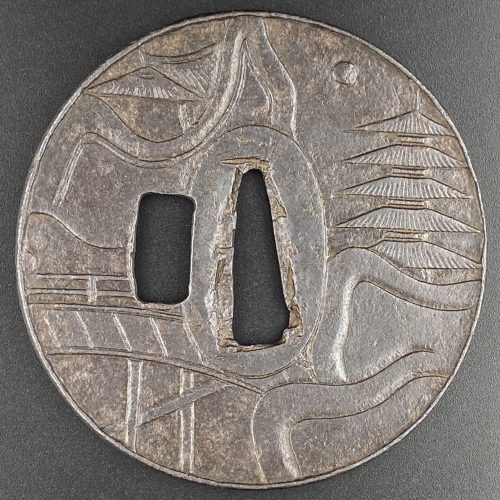
The thin iron plate of round form and black colour carved in sukidashi-bori with the design of rocks, waves, bridge, mountain pavilion and 5-storey pagoda under the moon, on both sides, alluding to Todai-ji temple in Nara. Slightly rounded rectangular hitsu-ana probably pierced later. Very narrow raised rim as usual in katsushi tsuba. In a modern wooden box.
Late Muromachi period, 16th century. Dimensions: 81.1 x 79.5 x 3. mm (seppa-dai), 2.2 mm (base plate), 4.4. (rim).Reference: “Art of the Samurai” on page 232, №140: ”Kamakura tsuba with Sangatsu-do tower and bridge. Muromachi period, 16th century. 83 mm x 80 mm. Unsigned. Tokyo National Museum. The mountain pavilion and bridge carved in sunken relief on the iron tsuba – both part of Tōdai-ji, a temple in Nara – are detailed in fine kebori (line) engraving. As a result of the chiselling used to create the relief, the ground of the piece is relatively thin”. Also page 41 in Tsuba Kanshoki. Kazutaro Torogoye, 1975 [LIB-1480.2018].
This tsuba is very much similar to TSU-0384. -
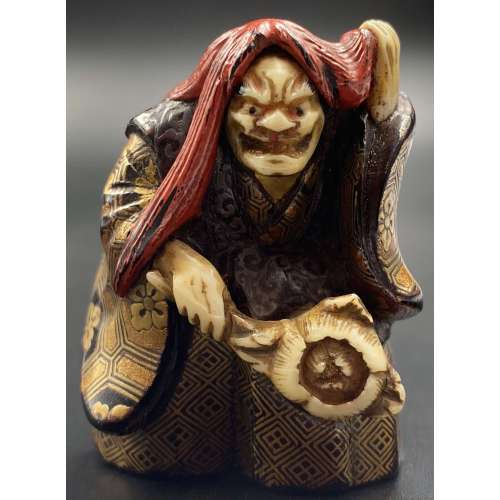 An actor dressed as a witch, with red hair, a gold patterned costume with tortoiseshell and flower lozenge design, and an inlaid ivory mask, hands, feet and flower blossom. Signature to the bottom: Kogyoku [光玉]. Dimensions: 4.17 x 3.07 x 2.99 cm. Provenance: Collection of Gloria and Joe Kurilecz. Sold by Eldred's, on August 25, 1993, Lot #699.
An actor dressed as a witch, with red hair, a gold patterned costume with tortoiseshell and flower lozenge design, and an inlaid ivory mask, hands, feet and flower blossom. Signature to the bottom: Kogyoku [光玉]. Dimensions: 4.17 x 3.07 x 2.99 cm. Provenance: Collection of Gloria and Joe Kurilecz. Sold by Eldred's, on August 25, 1993, Lot #699. -
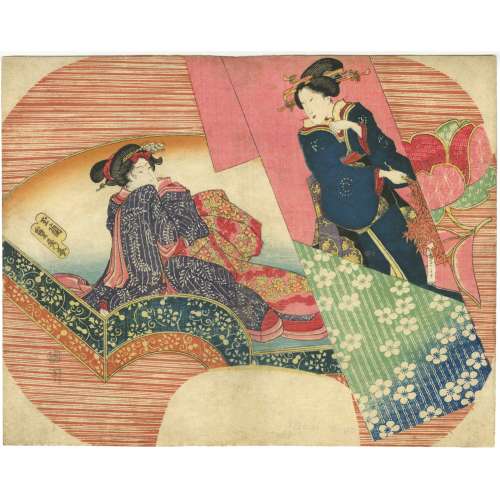 Artist: Utagawa Sadahide [歌川貞秀] (Japanese, 1807 – 1879). Publisher: Kojimaya Jūbei [小島屋重兵衛] (Japanese, c. 1797 – 1869); seal: Marks #264, p. 210) Signed: Gyokuransai Sadahide ga [玉蘭斎貞秀 画]. Date seal: 1830 (Bunsei 13 / Tenpō 1). Size: Uncut fan print (uchiwa-e); 229 x 292 mm
Artist: Utagawa Sadahide [歌川貞秀] (Japanese, 1807 – 1879). Publisher: Kojimaya Jūbei [小島屋重兵衛] (Japanese, c. 1797 – 1869); seal: Marks #264, p. 210) Signed: Gyokuransai Sadahide ga [玉蘭斎貞秀 画]. Date seal: 1830 (Bunsei 13 / Tenpō 1). Size: Uncut fan print (uchiwa-e); 229 x 292 mm -
 Artist: Utagawa Kunisada [歌川 国貞] a.k.a. Utagawa Toyokuni III [三代歌川豊国] (Japanese, 1786 – 1865). Signed: Kunisada ga [国貞画] in a yellow double-gourd cartouche. Publisher: Ibaya Senzaburo [伊場屋仙三郎] (Japanese, fl. c. 1845 – 1847). Date aratame seal: Bunsei 13 – Tenpō 1 (1830). Actor: Nakamura Utaemon IV [中村歌右衛門] (Japanese, 1796 – 1852); other names: Nakamura Shikan II [二代目中村芝翫], Nakamura Tsurusuke I, Nakamura Tōtarō. Play: Yoshitsune’s Letter at Koshigoe [義経腰越状] (Yoshitsune Koshigoe-jo). Uncut fan print (uchiwa-e, 団 扇 絵), 229 x 267 mm, depicting kabuki actor Nakamura Shikan [中村芝翫] as Gotobei [五斗兵衛]. Nakamura Utaemon IV held the name of Nakamura Shikan II from the 11th lunar month of 1825 to the 1st lunar month of 1836. He was born as Hirano Kichitarō in Edo in 1796. Another fan print with the same subject in this collection [SVJP-0344.2021]:
Artist: Utagawa Kunisada [歌川 国貞] a.k.a. Utagawa Toyokuni III [三代歌川豊国] (Japanese, 1786 – 1865). Signed: Kunisada ga [国貞画] in a yellow double-gourd cartouche. Publisher: Ibaya Senzaburo [伊場屋仙三郎] (Japanese, fl. c. 1845 – 1847). Date aratame seal: Bunsei 13 – Tenpō 1 (1830). Actor: Nakamura Utaemon IV [中村歌右衛門] (Japanese, 1796 – 1852); other names: Nakamura Shikan II [二代目中村芝翫], Nakamura Tsurusuke I, Nakamura Tōtarō. Play: Yoshitsune’s Letter at Koshigoe [義経腰越状] (Yoshitsune Koshigoe-jo). Uncut fan print (uchiwa-e, 団 扇 絵), 229 x 267 mm, depicting kabuki actor Nakamura Shikan [中村芝翫] as Gotobei [五斗兵衛]. Nakamura Utaemon IV held the name of Nakamura Shikan II from the 11th lunar month of 1825 to the 1st lunar month of 1836. He was born as Hirano Kichitarō in Edo in 1796. Another fan print with the same subject in this collection [SVJP-0344.2021]: "...The play Yoshitsune Koshigoe-jo was originally written for the puppet theatre (Bunraku) and staged for the first time in the 7th lunar month of 1754 in Ôsaka at the Toyotakeza. It was a revision of two early plays, Namiki Sōsuke's Nanbantetsu Gotō no Menuki (1735) and Yoshitsune Shin Fukumijō (1744). The title, which suggested that the play focused on Minamoto no Yoshitsune, was in fact dealing with the siege of the Ōsaka Castle, led by Tokugawa Ieyasu to destroy the Toyotomi clan in 1614 and 1615. This play was quickly forbidden because of the 4th act in which Gotobei's wife fired a gun at Yoritomo (this was of course interpreted as an attack on the Shogunate). Yoshitsune Koshigoe-jo was revised in 1770 by Toyotake Ōritsu, who completely rewrote the 4th act for a puppet production at the Kitahorieza in Ōsaka". Yoshitsune Koshigoe-jo was staged for the first time in Edo, at the Ichimuraza on the 9th lunar month of 1790, and is still performed.
Gotobei [五斗兵衛] (Gotohei or Gotobē), one of Yoshitsune’s loyal retainers, is forced to choose between his son’s life or his loyalty to Yoshitsune. Nishikidō brothers, who do not want Gotobei to become Yoshitsune's chief strategist, forced him to drink sake and get asleep. To prove Gotobei's military abilities, Izumi no Saburō fires a gun next to Gotobei's ear, and "he jumps up immediately, in full possession of his senses, ready to repulse any enemy". See: [LIB-1193.2013] Samuel L. Leiter. Kabuki Encyclopedia: An English-language adaptation of Kabuki Jiten. — Westport, CT; London: Greenwood Press, 1979; pp. 266-7).
Ref: [LIB-2993.2022] Fig. 24 in Israel Goldman. Japanese prints and paintings / 40th anniversary; Catalogue 27, 2021.
Two more Kunisada's fan prints (in Paul Griffith's collection), depicting the same actor Nakamura Shikan II as Toneri Matsuōmaru [舎人松王丸] were published in 1832 by Iseya Ichiemon. The play was Sugawara's Secrets of Calligraphy [菅原伝授手習鑑] (Sugawara Denju Tenarai Kagami). See: [LIB-1212.2017] Robert Schaap. Kunisada: Imaging, drama and beauty / Introduction by Sebastian Izzard, contributions by Paul Griffith and Henk. J. Herwig. — Leiden: Hotei Publishing, ©2016.
"...The play Yoshitsune Koshigoe-jo was originally written for the puppet theatre (Bunraku) and staged for the first time in the 7th lunar month of 1754 in Ôsaka at the Toyotakeza. It was a revision of two early plays, Namiki Sōsuke's Nanbantetsu Gotō no Menuki (1735) and Yoshitsune Shin Fukumijō (1744). The title, which suggested that the play focused on Minamoto no Yoshitsune, was in fact dealing with the siege of the Ōsaka Castle, led by Tokugawa Ieyasu to destroy the Toyotomi clan in 1614 and 1615. This play was quickly forbidden because of the 4th act in which Gotobei's wife fired a gun at Yoritomo (this was of course interpreted as an attack on the Shogunate). Yoshitsune Koshigoe-jo was revised in 1770 by Toyotake Ōritsu, who completely rewrote the 4th act for a puppet production at the Kitahorieza in Ōsaka". Yoshitsune Koshigoe-jo was staged for the first time in Edo, at the Ichimuraza on the 9th lunar month of 1790, and is still performed.
Gotobei [五斗兵衛] (Gotohei or Gotobē), one of Yoshitsune’s loyal retainers, is forced to choose between his son’s life or his loyalty to Yoshitsune. Nishikidō brothers, who do not want Gotobei to become Yoshitsune's chief strategist, forced him to drink sake and get asleep. To prove Gotobei's military abilities, Izumi no Saburō fires a gun next to Gotobei's ear, and "he jumps up immediately, in full possession of his senses, ready to repulse any enemy". See: [LIB-1193.2013] Samuel L. Leiter. Kabuki Encyclopedia: An English-language adaptation of Kabuki Jiten. — Westport, CT; London: Greenwood Press, 1979; pp. 266-7).
Ref: [LIB-2993.2022] Fig. 24 in Israel Goldman. Japanese prints and paintings / 40th anniversary; Catalogue 27, 2021.
Two more Kunisada's fan prints (in Paul Griffith's collection), depicting the same actor Nakamura Shikan II as Toneri Matsuōmaru [舎人松王丸] were published in 1832 by Iseya Ichiemon. The play was Sugawara's Secrets of Calligraphy [菅原伝授手習鑑] (Sugawara Denju Tenarai Kagami). See: [LIB-1212.2017] Robert Schaap. Kunisada: Imaging, drama and beauty / Introduction by Sebastian Izzard, contributions by Paul Griffith and Henk. J. Herwig. — Leiden: Hotei Publishing, ©2016.


-
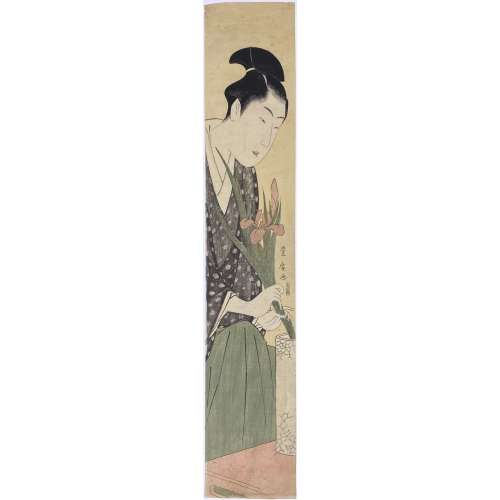 Artist: Utagawa Toyohiro [歌川豐廣] (Japanese, 1773 – 1828) Publisher: Takasu Soshichi (Marks 25-247 / 517) Size: pillar print (hashira-e), 69.2 x 13 cm.
Artist: Utagawa Toyohiro [歌川豐廣] (Japanese, 1773 – 1828) Publisher: Takasu Soshichi (Marks 25-247 / 517) Size: pillar print (hashira-e), 69.2 x 13 cm.Signed: Toyohiro ga [豐廣画]
Catalogue raisonné: Jacob Pins, The Japanese Pillar Print, № 923, p. 326. -
 Iron tsuba of round form, tapering from centre to the rim, decorated with eight roundels – circular emblems of flowers and/or family crests (mon) made of cast brass, pierced and chiselled in kebori, and with flat brass inlay (hira-zōgan) of water plantain (omodaka) and seaweed all over the plate. Hitsu-ana outlined in brass. Four positive silhouette roundels are 3-, 6-, 9-, and 12 – pointing crests/flowers; four negative silhouette roundels – bellflower, cherry and plum blossoms. Yoshirō school (Kaga-Yoshirō). Unsigned. The Momoyama or early Edo period, end of the 16th to the first half of the 17th century (1574-1650). Size: H: 88.3 mm; W: 88.7 mm; Thickness 4.0 mm (Seppa-dai), 3,2 cm (rim). Other Kaga-Yoshiro tsuba in this collection: TSU-0334: 7.7 cm; TSU-0342.2017: 89.6 cm; TSU-0344: 8.1 cm; TSU-0329: 8.0 cm; TSU-0376.2018: 8.1 cm; TSU-0379.2018: 8.2 cm. We see that the usual size is about 8 cm; larger pieces, such as this one and TSU-0342.2017 dedicated to Hachiman, are rare. Article about Yoshiro tsuba.
Iron tsuba of round form, tapering from centre to the rim, decorated with eight roundels – circular emblems of flowers and/or family crests (mon) made of cast brass, pierced and chiselled in kebori, and with flat brass inlay (hira-zōgan) of water plantain (omodaka) and seaweed all over the plate. Hitsu-ana outlined in brass. Four positive silhouette roundels are 3-, 6-, 9-, and 12 – pointing crests/flowers; four negative silhouette roundels – bellflower, cherry and plum blossoms. Yoshirō school (Kaga-Yoshirō). Unsigned. The Momoyama or early Edo period, end of the 16th to the first half of the 17th century (1574-1650). Size: H: 88.3 mm; W: 88.7 mm; Thickness 4.0 mm (Seppa-dai), 3,2 cm (rim). Other Kaga-Yoshiro tsuba in this collection: TSU-0334: 7.7 cm; TSU-0342.2017: 89.6 cm; TSU-0344: 8.1 cm; TSU-0329: 8.0 cm; TSU-0376.2018: 8.1 cm; TSU-0379.2018: 8.2 cm. We see that the usual size is about 8 cm; larger pieces, such as this one and TSU-0342.2017 dedicated to Hachiman, are rare. Article about Yoshiro tsuba. -
 An uncut fan print shows a young woman holding a basket on a landscape background with hills and pines under a rising sun. Haruo Shirane: "Under the luni-solar calendar, the New Year coincided with the beginning of spring, making it the most important observance of the year for the aristocracy. In the Heian period, New Year ceremonies extended from New Year’s Day (Ganjitsu) to the Day of the Rat (Nenohi), which usually fell on the seventh day of the First Month, when courtiers went out to the fields (no), pulled up small pines, and gathered new herbs (wakana) as a prayer for long life. This ritual gradually spread to the provinces and to commoners, eventually resulting in the New Year practice of the gate pine (kadomatsu), in which a pair of small pines was placed at the gate of a house. A popular Heian-period painting topic representing the First Month was “prayers on the Day of the Rat” (Nenohi no asobi), which depicted the auspicious scene of pulling up small pines in a spring field. Both young herbs and gathering young herbs, particularly at Kasuga Field, became major poetic topics for the First Month, appearing in both the spring and celebration (ga) books of the Kokinshū (Collection of Japanese Poems Old and New, ca. 905). By the Kamakura period, the observance of the Day of the Rat had been abandoned at the imperial court, but the custom of gathering and eating young greens continued as the annual ceremony known as the Seven Grasses (Nanakusa). Note: The Heian-period ritual of pulling up the roots of small pines (komatsu ) on the first Day of the Rat derives from the homonyms ne (rat) and ne (root). Pulling up roots was auspicious, since it implied lengthening the year. The rising sun (hinode) was considered an auspicious sight, particularly at the beginning of the year". [Haruo Shirane, Japan and the Culture of the Four Seasons. Nature, Literature, and the Arts. — Columbia University, NY, 2012]. Title: Gathering of the young herbs on the Day of the Rat [子の日乃若菜] (Nenohi no wakana). Series: Three elegant sources of light [風流三光の内] (fūryū sankō no uchi); meaning the sun, the moon and the stars). Artist: Utagawa Kunisada [歌川 国貞]; a.k.a. Utagawa Toyokuni III [三代歌川豊国] (Japanese, 1786 – 1865). Signed: Toyokuni ga [豊国 画] in a yellow toshidama cartouche. Publisher’s seal: Izuzen (Marks: seal 06-029 | U103b) Date and double nanushi censor seals: Mera and Watanabe, Kaei 6 (1853). A similar theme can be found in Kunisadai's triptych published in about 1844 (HARA SHOBO):
An uncut fan print shows a young woman holding a basket on a landscape background with hills and pines under a rising sun. Haruo Shirane: "Under the luni-solar calendar, the New Year coincided with the beginning of spring, making it the most important observance of the year for the aristocracy. In the Heian period, New Year ceremonies extended from New Year’s Day (Ganjitsu) to the Day of the Rat (Nenohi), which usually fell on the seventh day of the First Month, when courtiers went out to the fields (no), pulled up small pines, and gathered new herbs (wakana) as a prayer for long life. This ritual gradually spread to the provinces and to commoners, eventually resulting in the New Year practice of the gate pine (kadomatsu), in which a pair of small pines was placed at the gate of a house. A popular Heian-period painting topic representing the First Month was “prayers on the Day of the Rat” (Nenohi no asobi), which depicted the auspicious scene of pulling up small pines in a spring field. Both young herbs and gathering young herbs, particularly at Kasuga Field, became major poetic topics for the First Month, appearing in both the spring and celebration (ga) books of the Kokinshū (Collection of Japanese Poems Old and New, ca. 905). By the Kamakura period, the observance of the Day of the Rat had been abandoned at the imperial court, but the custom of gathering and eating young greens continued as the annual ceremony known as the Seven Grasses (Nanakusa). Note: The Heian-period ritual of pulling up the roots of small pines (komatsu ) on the first Day of the Rat derives from the homonyms ne (rat) and ne (root). Pulling up roots was auspicious, since it implied lengthening the year. The rising sun (hinode) was considered an auspicious sight, particularly at the beginning of the year". [Haruo Shirane, Japan and the Culture of the Four Seasons. Nature, Literature, and the Arts. — Columbia University, NY, 2012]. Title: Gathering of the young herbs on the Day of the Rat [子の日乃若菜] (Nenohi no wakana). Series: Three elegant sources of light [風流三光の内] (fūryū sankō no uchi); meaning the sun, the moon and the stars). Artist: Utagawa Kunisada [歌川 国貞]; a.k.a. Utagawa Toyokuni III [三代歌川豊国] (Japanese, 1786 – 1865). Signed: Toyokuni ga [豊国 画] in a yellow toshidama cartouche. Publisher’s seal: Izuzen (Marks: seal 06-029 | U103b) Date and double nanushi censor seals: Mera and Watanabe, Kaei 6 (1853). A similar theme can be found in Kunisadai's triptych published in about 1844 (HARA SHOBO):
豊国三代「豊歳子日若菜摘ノ図」
-
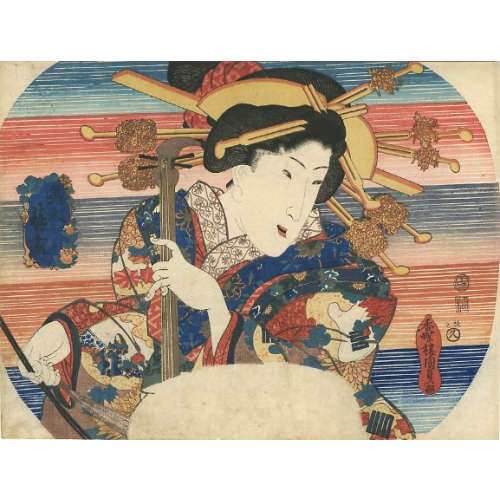 A young woman playing a four-string musical instrument with a bow (kokyū). Series: Assortments of Beauties Accomplishments [美人芸盡] (Bijin gei-zukushi). Utagawa Kunisada [歌川 国貞]; a.k.a. Utagawa Toyokuni III [三代歌川豊国] (Japanese, 1786 – 1865). Signed: Kochoro Kunisada ga [香蝶楼 国貞画] in a red double gourd cartouche. Publisher: Ibaya Kyūbei [伊場屋久兵衛] (Japanese, 1804 – 1851); seal: Hanmoto, Kyū [板元久] (Marks 19-040 | 126e) Date seal: Bunsei 12 (1829). Censors' seal: Kiwame. Size: Fan print (uchiwa-e).
A young woman playing a four-string musical instrument with a bow (kokyū). Series: Assortments of Beauties Accomplishments [美人芸盡] (Bijin gei-zukushi). Utagawa Kunisada [歌川 国貞]; a.k.a. Utagawa Toyokuni III [三代歌川豊国] (Japanese, 1786 – 1865). Signed: Kochoro Kunisada ga [香蝶楼 国貞画] in a red double gourd cartouche. Publisher: Ibaya Kyūbei [伊場屋久兵衛] (Japanese, 1804 – 1851); seal: Hanmoto, Kyū [板元久] (Marks 19-040 | 126e) Date seal: Bunsei 12 (1829). Censors' seal: Kiwame. Size: Fan print (uchiwa-e). -
 Artist: Utagawa Kuniyasu [歌川 国安] (Japanese, 1794–1832). Publisher seal: [太] (Ta): Marks 02-050 | U421b: An unknown publisher in Edo, fl. c. 1815-61; name assigned according to seal shape “Yama-Ta“. Signed: Kuniyasu ga [国安 画]. Date-aratame seal: Bunsei 9 (1826). Actors: Iwai Hanshirō VI [岩井半四郎] (Japanese, 1799 – 1836), other names: Iwai Hanshirō VI, Iwai Kumesaburō II, Iwai Hisajirō I, Baiga (poetry name), Shūka (poetry name) — as Shirai Gonpachi [白井權八]. Ichikawa Danjūrō VII 市川団十郎 (Japanese, 1791 – 1859), other names: Ichikawa Ebizō V, Ichikawa Hakuen II, Ichikawa Shinnosuke I — as Banzui Chōbei [幡随長兵衛]. Kabuki play: Suzugamori [Suzu-ga-Mori, 鈴ヶ森], a.k.a. Ukiyozuka Hiyoku no Inazuma written by Tsuruya Nanboku IV (Japanese, c. 1755 – 1829). First staged in 1823 at Ichimura-za [市村座] in Edo. Plot: "A gang of evil palanquin bearers are stationed near the Suzugamori execution grounds, where they lay in wait to rob travellers passing through. Gonpachi, who killed a man in his home province, is being sought by the police. He is fleeing to Edo when the bearers attack him in hopes of claiming a reward. He beats them off with great skill. Banzui Chōbei, who is being carried by in a palanquin, sees the attack, admires Gonpachi's ability, and promises to aid him if he is going to Edo". [Samuel L. Leiter. Historical Dictionary of Japanese Traditional Theatre. — Rowman & Littlefield, 2014; p. 382-3.; LIB-2110.2019]. Ref.: Sotheby's.
Artist: Utagawa Kuniyasu [歌川 国安] (Japanese, 1794–1832). Publisher seal: [太] (Ta): Marks 02-050 | U421b: An unknown publisher in Edo, fl. c. 1815-61; name assigned according to seal shape “Yama-Ta“. Signed: Kuniyasu ga [国安 画]. Date-aratame seal: Bunsei 9 (1826). Actors: Iwai Hanshirō VI [岩井半四郎] (Japanese, 1799 – 1836), other names: Iwai Hanshirō VI, Iwai Kumesaburō II, Iwai Hisajirō I, Baiga (poetry name), Shūka (poetry name) — as Shirai Gonpachi [白井權八]. Ichikawa Danjūrō VII 市川団十郎 (Japanese, 1791 – 1859), other names: Ichikawa Ebizō V, Ichikawa Hakuen II, Ichikawa Shinnosuke I — as Banzui Chōbei [幡随長兵衛]. Kabuki play: Suzugamori [Suzu-ga-Mori, 鈴ヶ森], a.k.a. Ukiyozuka Hiyoku no Inazuma written by Tsuruya Nanboku IV (Japanese, c. 1755 – 1829). First staged in 1823 at Ichimura-za [市村座] in Edo. Plot: "A gang of evil palanquin bearers are stationed near the Suzugamori execution grounds, where they lay in wait to rob travellers passing through. Gonpachi, who killed a man in his home province, is being sought by the police. He is fleeing to Edo when the bearers attack him in hopes of claiming a reward. He beats them off with great skill. Banzui Chōbei, who is being carried by in a palanquin, sees the attack, admires Gonpachi's ability, and promises to aid him if he is going to Edo". [Samuel L. Leiter. Historical Dictionary of Japanese Traditional Theatre. — Rowman & Littlefield, 2014; p. 382-3.; LIB-2110.2019]. Ref.: Sotheby's.


